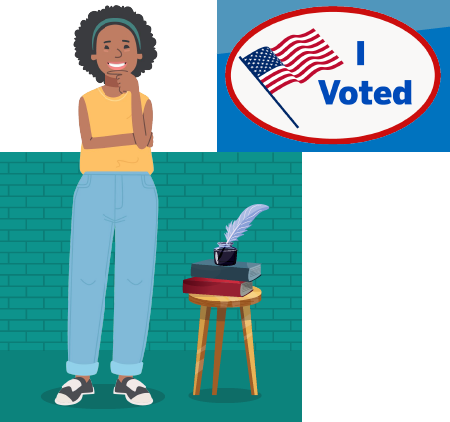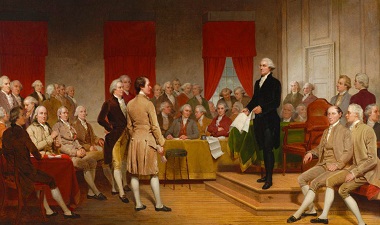
Getting Started
This module includes two Unboxing the Constitution videos (4 min and 5 min), an Inside the Constitution video (8 min), student activities, and a learning project. Download the Teachers Guide and the Student Content Guide for more details on content and implementation. Course materials are provided in Google documents, Word documents, as well as printable PDFs.
A preview of the module can be accessed below.
Topics covered include:
- Elections in the Constitution
- The Electoral College
- Voting Rights Amendments
- Suffrage in the Progressive and Civil Rights Eras

Vocabulary
At the beginning of each module, students are presented with vocabulary words and definitions.
Concept Words
Concept words are conceptually related to the big ideas in what they’re learning. These connect directly to the core concepts or themes of the lesson or unit and help students grasp the main ideas and how everything fits together.
- ballot: a piece of paper or electronic form used to vote in an election
- candidate: a person who is running for a position, like president or mayor, in an election
- citizenship: the status of being a member of a country, with rights and responsibilities like voting and following laws
- discriminatory: treating people unfairly, commonly because of their race, gender, or other difference
- Electoral College: a special group of people who officially choose the president of the United States based on votes from each state
- Jim Crow laws: past laws that treated Black Americans unequally and took away their rights, especially in the South
- gerrymandering: changing the borders of voting areas in a way that helps one political group win
- poll tax: a fee required to register or vote, commonly used to keep Black Americans and poor people from voting
- populism: a way of thinking in politics that focuses on the needs and wishes of regular people instead of powerful leaders
- suffrage: the right to vote in elections
- white primary: a practice used in the South of only allowing white voters to vote in primary elections, thus limiting the influence of Black voters
Speed Bump Words
Speed bump words are words that aren’t central to the concept being taught, but if students don’t understand them, they may struggle to comprehend the text or lesson. These words can help shape students' overall understanding of the topic.
- authority: the power or right to give orders, make decisions, or enforce rules
- composed: made up of different parts or pieces that form a whole
- election: a process where people vote to choose leaders or decide on laws
- eligible: allowed to do something because you meet the requirements, like being old enough to vote
- numerous: a large number of something
- persistence: not giving up, even when something is difficult or takes a long time
- qualification: a skill, experience, or rule that allows someone to do a job or take part in something
- reinforce: to make something stronger or more certain
- restriction: a rule or limit that controls what can be done
- requisite: something that is needed for a certain purpose

Topic 1: Voting Rights from the Early Republic to Reconstruction
Voting rights in the U.S. have changed a lot since the Constitution was written. The original Constitution outlined the basic rules for elections and voting in America. At first, it gave states most of the power to run elections. It also created systems like the Electoral College for choosing the president. Over time, the federal government and individual states made new laws and the American people pushed for constitutional amendments that have reshaped elections and expanded voting rights.
13.1: Activate Prior Knowledge
To start this module, students will think about what they already know about voting rights, and what they still have questions about.
Unboxing the Constitution - Video One
In this Unboxing the Constitution video, Lucy discusses the history of voting rights in America through constitutional amendments, key pieces of legislation, and landmark Supreme Court decisions.
13.2: Elections and Constitutional Change
Students will dive into Articles I and II of the Constitution to learn more about elections and constitutional change. They can work with a partner to explore the meaning of the text, and join other students to learn about their assigned sections.
13.3: Electoral College
In this activity, students will work toward answering the following questions: What do you think about the Electoral College? Should it be changed, abolished, or kept as is? Think about questions like:
- How do you think the Electoral College balances power between big and small states?
- What do you think are some possible problems with and advantages of the Electoral College?
Use the Teachers Guide for strategies on how to facilitate this discussion with your students.
13.4: Expanding Elections
How did voting rights amendments and legislation expand or enforce the right to vote? Students will explore the following amendments and pieces of legislation and think about the influence of the federal government, the connections to the fundamental principles of the Constitution and the right to vote.
13.5: Voting Amendments and Protections
Students will watch the Inside the Constitution video and use the Video Notes handout to organize the information that is shared, deepen understanding and gain insights into voting rights throughout American History.
Inside the Constitution
13.6: Closing Activity
Students will check in on the Key Question(s).

Topic 2: Suffrage in the Progressive and Civil Rights Era
The 15th Amendment may have extended voting rights to Black American men. But the fight to actually use those voting rights continued long after it was ratified. For women, it took another amendment, the 19th Amendment to secure voting rights nationwide.
13.7: Women's Suffrage
In this activity, students will work with a partner to read an overview of the women’s suffrage movement throughout history and share key insights.
They should then watch the Unboxing the Constitution video to gain insight into voting rights in America from the Progressive Era and beyond.
Unboxing the Constitution, Video Two
13.8: Voting, the Civil Rights Movement, and the Court
Students will explore two Supreme Court cases related to voting and the Civil Rights Movement– United States v. Reese and Smith v. Allwright. Use the Teachers Guide and Student Content Guide for insights on how to shape discussions around these cases.
13.9: Civic Connection: Voting in Your Community
In this Civic Connection activity, students will explore what voting looks like in their community. Where do people go to vote? What are ways to become an informed voter? They will research how these questions and more connect to where they live.
13.10: Reflect
Students will revisit the brainstorm activity and key question reflection to see how insights have grown throughout the lesson.

Learning Project
In this project, students will explore these pivotal moments by creating a podcast episode that captures key events, figures, laws, and Supreme Court cases that have defined voting rights throughout U.S. history.













